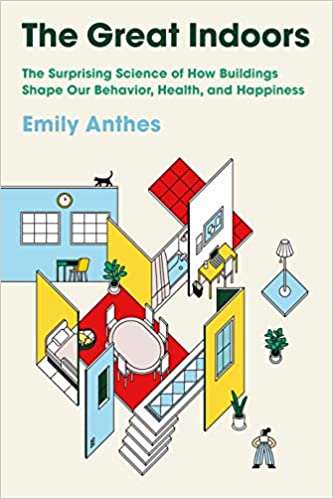You have /5 articles left.
Sign up for a free account or log in.
 The Great Indoors: The Surprising Science of How Buildings Shape Our Behavior, Health, and Happiness by Emily Anthes
The Great Indoors: The Surprising Science of How Buildings Shape Our Behavior, Health, and Happiness by Emily Anthes
Published in June of 2020.
It’s been over four months since I last spent the day working in my campus office. At least for now, many of us in higher ed are living at our offices.
Side note: The best description of working during COVID-19 I’ve heard is that we are now living at work, not working from home.
Should we take some of this enforced remote working time, for those of us privileged enough to work at home, to think about what we want from our campus workspaces once we return?
An excellent place to start would be to read and discuss Emily Anthes’ new book, The Great Indoors. This book describes an emerging applied discipline that I was only vaguely aware of, the study and practice of data-driven architecture.
Given that we spend 90 percent of our time indoors, you’d think that the design of our indoor spaces would be driven by careful analysis. Not so much. Our indoor spaces - and possibly the places you work when you go to campus - are mostly designed in response to factors such as costs and ideologies, not data.
The classic example, one which Anthes covers in the book, is open offices. How many of you spend your campus days (when we had campus days) in open-plan seating arrangements. Open offices were sold to us (including higher ed) as a way to catalyze collaboration and information exchange.
The data show that open offices curtail collaborations and discussions, as people avoid distractions by wearing headphones. The casual and substantive conversations that were once possible when people had doors to close move instead to e-mail or Slack. Digitally-mediated communication is a poor substitute for face-to-face conversation.
Plus, open offices lead to more sick days and lower retention. A data-driven design approach, rather than one based on pet theories (open=communications) or costs (open is cheaper), may have led many schools to avoid moving to open offices.
In The Great Indoors, we learn about not only effective design strategies for offices but also what works (and doesn’t) in environments as varied as hospitals, schools, houses, and prisons. Good indoor design need not be more expensive than bad design. What is required is the discipline to make data-informed decisions while also be willing to abandon long-held design beliefs and practices.
It is fascinating to learn how the research on the human impact of indoor space design is carried out. This is a truly interdisciplinary field, bringing in social scientists, architects, designers, cognitive scientists. In our higher ed context, I would add to this mix the people who work on classroom design and technologies. The higher ed professionals who think about learning spaces are some of the most brilliant folks on any campus. I think they would like this book.
As with almost every nonfiction book that I read, I wish that that the author had chosen college campuses as one of the case studies. What better environments to study the impact of data on design than classrooms? How many schools continue to build fixed, tier-seating lecture halls - where the data on student learning outcomes points to the effectiveness of flat classrooms with moveable furniture?
Another rich higher ed area to explore data-driven design is academic libraries. Librarians have been leading higher education in forward-thinking architecture. The academic library world is ahead of the rest of higher ed in designing their spaces around the needs of students and faculty while moving away from outmoded practices.
This may be an excellent time to think about the campus work environments we want to return to.
I recommend The Great Indoors as a book that can get us thinking and talking about our campus indoor spaces.
What are you reading?








